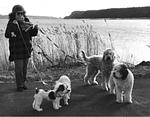BARBARA MEYER: SAVING LIVES, ONE DOG AT A TIME
Maybe you’ve seen a woman with red hair walking down Closter Road, being pulled by a pack of dogs and yelling at passing cars to slow down. That’s Barbara Meyer. The dogs, Kenny, Lily and Chance, are her failed fosters - “failed” because Barbara fell in love with them and couldn’t let them go.
Barbara has been fostering since 2015 with the Doodle Rescue Collective, a not-for-profit organization that specializes in re-homing poodle mixes. Dogs in foster care awaiting placement in a permanent home might stay with Barbara for up to two months while they undergo intensive rehabilitation if it’s needed, and it often is. Her doodle Kenny, for example, and I’m sure he wouldn’t mind my telling you this, came from Tarrytown where he’d been abandoned for guarding. Once he had something, he would not give it up and would just as soon maul you if you tried to take it away. Barbara arranged for him to have seven months of intensive therapy and he’s been well behaved now for over three years.
Kenny is not alone. Most fostered dogs have issues. They’re given away because of bad behavior, usually stemming from poor treatment, wrong environment or irresponsible breeding. In one case, a dog Barbara brought home was so scared that he would not come inside and Barbara had to sit out in the snow “like a Buddha” to coax him to eat. As she says in her succinct way, “Designer dogs can have the worst traits of mixed breeds; they might look good but have a screw loose and then they get dumped.” Barbara brings in a canine coach for the more difficult cases, but mostly she works with the dogs herself. She’s gotten two off psychotropic medications. One, on Prozac, didn’t like kids or living in the city. Removing her to a home in the country with no children allowed the dog to come off medication.
Barbara’s first foster project involved picking up two dogs from an elderly man whose wife had just died. They met in a parking lot in Connecticut, at night in the rain, more like moles exchanging state secrets. The dogs had been neglected and the widower admitted they were too much for him now that he was alone; they hopped into Barbara’s car with little coaxing. She fed them some chicken nuggets and, she says, they thought they were in heaven.
Barbara stays in touch with all her adopting families. She even arranges doggie play dates with them. She credits training dogs with making herself more consistent and more tolerant. They force her to get outside, get exercise and meet the neighbors.
The number of unplaced animals killed nation-wide in shelters each year decreased from 17 million to about 800,000 because of the efforts of organizations and individuals like Barbara.
In 2001, Tompkins County upstate became the second no-kill community in the nation after San Francisco. Since then, 171 additional New York towns have met the requirements for designation as no-kill districts, giving our state an overall save rate of 86% compared to the national rate of 77%.
The Best Friends Animal Society, the organization behind the no-kill movement, has as its goal to make the entire country no-kill by 2025. That means fostering and re-homing at least 90% of animals taken to shelters, rehabilitating them wherever possible.
Best Friends operates 20,700 acres of sanctuary in Utah for companion and retired professional animals unable to find homes. It works with city shelters, animal welfare agencies, advocates and volunteers all over the country.
Barbara says the volunteers she has worked with may have differences about politics or social issues, but on animal welfare, they are in total agreement.
For more information on pet fostering and adoption, go to https://bestfriends.org and doodlerescueinc.ning.com. Jackie Vorenkamp .


